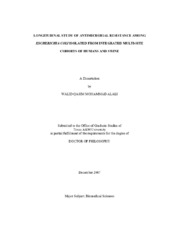| dc.description.abstract | Many studies have attempted to link antimicrobial use in food animal agriculture
with an increased risk of antimicrobial-resistant (AR) bacterial levels in humans. Our
data arise from longitudinal aggregated fecal samples in a 3-year cohort study of
vertically integrated populations of human workers and consumers, and swine. Human
and swine E. coli isolates (N = 2130 and 3485, respectively) were tested for
antimicrobial susceptibility using the SensititreTM broth microdilution system. The
associations between AR prevalence for each antimicrobial agent, multi-drug resistant E.
coli, or multivariate AR E. coli, and the risk factors (host species, production type
(swine), vocation (human swine worker versus non-worker), and season) in the study
were assessed using generalized estimating equations (GEE), GLM with multinomial
distribution, or GEE in a multivariate model using a SAS® macro to adjust for the
correlated AR phenotypes. There were significant (p < 0.05) differences in AR isolates:
1) between host-species with swine at higher risk for ceftiofur, chloramphenicol,
gentamicin, kanamycin, streptomycin, sulfisoxazole, and tetracycline. The prevalence of
ciprofloxacin, nalidixic acid, and trimethoprim/sulfamethoxazole resistance were higher among human isolates, 2) swine production group was significantly associated with AR
with purchased boars, nursery piglets, and breeding boars at a higher risk of resistance to
streptomycin and tetracycline, and 3) human swine worker cohorts exhibited an elevated
tetracycline prevalence, but lowered sulfisoxazole prevalence when compared to nonworkers.
High variability among seasonal samples over the 3-year period was observed.
There were significant differences in multiple resistance isolates between host species,
with swine at higher risk than humans of carrying multi-resistant strains; however, no
significant differences in multiple resistance isolates within humans by vocation or
within swine by production group. The odds-ratios, adjusted for multivariate
dependence of individual AR phenotypes, were increased relative to unadjusted oddsratios
among 1) swine as compared to human for tetracycline (OR = 21.8 vs. 19.6), and
2) increased significantly among swine-workers as compared to non-workers only for
tetracycline (OR = 1.4 vs. 1.3). Occupational exposure to swine-rearing facilities
appears to be associated with an increased relative odds for the prevalence of
tetracycline resistance compared to non-workers. | en |


